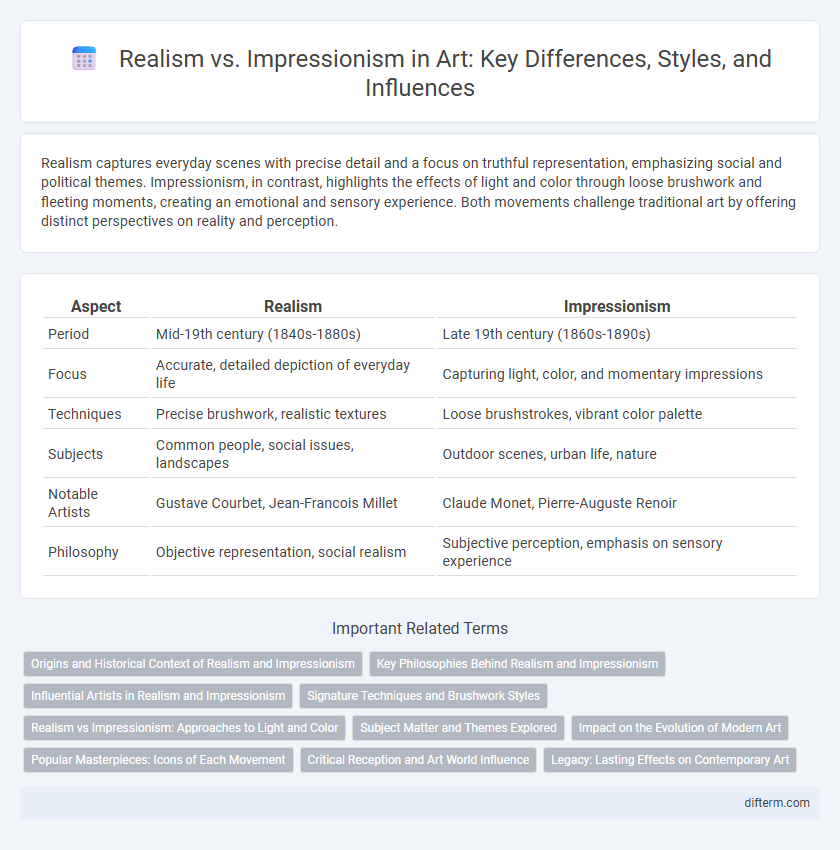Realism captures everyday scenes with precise detail and a focus on truthful representation, emphasizing social and political themes. Impressionism, in contrast, highlights the effects of light and color through loose brushwork and fleeting moments, creating an emotional and sensory experience. Both movements challenge traditional art by offering distinct perspectives on reality and perception.
Table of Comparison
| Aspect | Realism | Impressionism |
|---|---|---|
| Period | Mid-19th century (1840s-1880s) | Late 19th century (1860s-1890s) |
| Focus | Accurate, detailed depiction of everyday life | Capturing light, color, and momentary impressions |
| Techniques | Precise brushwork, realistic textures | Loose brushstrokes, vibrant color palette |
| Subjects | Common people, social issues, landscapes | Outdoor scenes, urban life, nature |
| Notable Artists | Gustave Courbet, Jean-Francois Millet | Claude Monet, Pierre-Auguste Renoir |
| Philosophy | Objective representation, social realism | Subjective perception, emphasis on sensory experience |
Origins and Historical Context of Realism and Impressionism
Realism emerged in the mid-19th century as a response to Romanticism, focusing on depicting everyday life and social realities with accurate detail, rooted in the political and social upheavals of post-1848 France. Impressionism, developing in the 1870s, broke from Realism by emphasizing light, color, and transient moments, influenced by technological advances like photography and changes in urban life during the Industrial Revolution. Both movements reflect distinct reactions to their historical contexts: Realism grounded in political reform and social consciousness, Impressionism in modernity and sensory experience.
Key Philosophies Behind Realism and Impressionism
Realism emphasizes accurate, detailed depictions of everyday life without idealization, focusing on social realities and ordinary subjects to reflect truth and objectivity. Impressionism prioritizes capturing fleeting moments, light effects, and sensory impressions using loose brushwork and vibrant colors to evoke emotional responses. These contrasting philosophies highlight Realism's commitment to factual representation versus Impressionism's exploration of perception and atmosphere.
Influential Artists in Realism and Impressionism
Gustave Courbet and Jean-Francois Millet spearheaded the Realism movement by portraying everyday life with stark, unidealized detail, influencing artists to embrace social and political themes in their work. In contrast, Claude Monet and Edgar Degas defined Impressionism through their innovative use of light, color, and brushstroke techniques, capturing fleeting moments and the sensory experience of scenes. Both movements reshaped the trajectory of 19th-century art, with Realism grounding viewers in the tangible world and Impressionism pioneering visual experimentation.
Signature Techniques and Brushwork Styles
Realism emphasizes meticulous detail and precise brushwork to capture subjects with clarity and authenticity, often using smooth, polished surfaces that minimize visible strokes. Impressionism employs loose, rapid brushstrokes and vibrant colors to convey light and movement, prioritizing sensory impressions over exact representation. Signature techniques in Impressionism include broken color and wet-on-wet application, contrasting with Realism's controlled layering and fine detail.
Realism vs Impressionism: Approaches to Light and Color
Realism emphasizes precise representations of light and color to depict scenes truthfully, often using muted tones and sharp contrasts to capture everyday life. In contrast, Impressionism explores the effects of natural light through loose brushwork and vibrant colors, aiming to convey the fleeting atmosphere rather than exact detail. The differing approaches highlight Realism's focus on accuracy versus Impressionism's interest in perception and momentary visual experiences.
Subject Matter and Themes Explored
Realism centers on everyday life and ordinary people, depicting social realities with meticulous detail and an emphasis on truthful representation. Impressionism explores fleeting moments, light effects, and sensory impressions, often focusing on landscapes, urban scenes, and leisure activities. Thematically, Realism addresses social issues and the human condition, while Impressionism captures atmosphere and perception through vibrant color and brushwork.
Impact on the Evolution of Modern Art
Realism's focus on everyday life and unembellished subjects challenged the idealized norms of academic art, laying the groundwork for a more authentic artistic expression. Impressionism evolved by emphasizing light, color, and fleeting moments, breaking traditional techniques and influencing modern art's move toward abstraction and experimentation. Together, these movements propelled the shift from representational art to innovative forms that define modern art's diverse and dynamic nature.
Popular Masterpieces: Icons of Each Movement
Realism is epitomized by Gustave Courbet's "The Stone Breakers," illustrating raw, unidealized depictions of everyday labor. Impressionism is famously represented by Claude Monet's "Impression, Sunrise," capturing fleeting light and atmospheric effects with loose brushwork. These masterpieces highlight the distinct philosophical and stylistic approaches defining each movement's artistic identity.
Critical Reception and Art World Influence
Realism, emerging in the mid-19th century, faced initial criticism for its stark, unidealized depictions of everyday life, which challenged traditional academic art standards and influenced artists to explore social and political themes. Impressionism, initially rejected by the Paris Salon for its loose brushwork and focus on light and color, gradually gained favor, reshaping the art world by emphasizing perception and momentary impressions. Both movements significantly impacted modern art, with Realism grounding art in social reality and Impressionism pioneering new visual techniques that influenced diverse subsequent styles.
Legacy: Lasting Effects on Contemporary Art
Realism's commitment to depicting everyday life with precise detail laid the groundwork for contemporary artists who emphasize authenticity and social commentary. Impressionism's focus on light, color, and fleeting moments revolutionized visual expression, influencing modern techniques like abstract and experimental painting. Both movements shaped contemporary art by expanding artistic boundaries and encouraging diverse interpretations of reality.
Realism vs Impressionism Infographic

 difterm.com
difterm.com